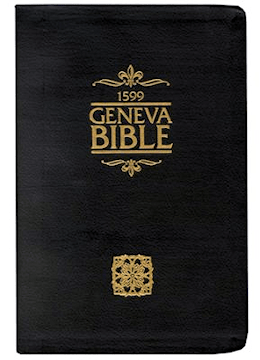Textus Receptus Bibles
Geneva Bible 1560/1599
| 9:1 | He cryed also with a loude voyce in mine eares, saying, The visitations of the citie draw neere, and euery man hath a weapon in his hande to destroy it. |
| 9:2 | And beholde, sixe men came by the way of the hie gate, which lieth towarde the North, and euery man a weapon in his hande to destroy it: and one man among them was clothed with linen, with a writers ynkhorne by his side, and they went in and stoode beside the brasen altar. |
| 9:3 | And the glorie of the God of Israel was gone vp from ye Cherub, whereupon he was and stoode on the doore of the house, and he called to the man clothed with linnen, which had the writers ynkhorne by his side. |
| 9:4 | And the Lord said vnto him, Goe through the middes of the citie, euen through the middes of Ierusalem and set a marke vpon the foreheads of them that mourne, and cry for all the abominations that be done in the middes thereof. |
| 9:5 | And to the other he said, that I might heare, Goe ye after him through the citie, and smite: let your eye spare none, neither haue pitie. |
| 9:6 | Destroy vtterly the old, and the yong, and the maides, and the children, and the women, but touch no man, vpon whome is the marke, and begin at my Sanctuarie. Then they began at the Ancient men, which were before the house. |
| 9:7 | And he sayde vnto them, Defile the house, and fill the courtes with the slaine, then goe foorth: and they went out, and slewe them in the citie. |
| 9:8 | Nowe when they had slaine them, and I had escaped, I fell downe vpon my face, and cryed, saying, Ah Lord God, wilt thou destroy all the residue of Israel, in powring out thy wrath vpon Ierusalem? |
| 9:9 | Then saide he vnto me, The iniquitie of the house of Israel, and Iudah is exceeding great, so that the lande is full of blood, and the citie full of corrupt iudgement: for they say, The Lord hath forsaken the earth, and the Lord seeth vs not. |
| 9:10 | As touching me also, mine eye shall not spare them, neither will I haue pitie, but will recompence their wayes vpon their heades. |
| 9:11 | And beholde, the man clothed with linen which had the ynkhorne by his side, made report, and saide, Lord, I haue done as thou hast commanded me. |

Geneva Bible 1560/1599
The Geneva Bible is one of the most influential and historically significant translations of the Bible into English, preceding the King James translation by 51 years. It was the primary Bible of 16th century Protestantism and was the Bible used by William Shakespeare, Oliver Cromwell, John Knox, John Donne, and John Bunyan. The language of the Geneva Bible was more forceful and vigorous and because of this, most readers strongly preferred this version at the time.
The Geneva Bible was produced by a group of English scholars who, fleeing from the reign of Queen Mary, had found refuge in Switzerland. During the reign of Queen Mary, no Bibles were printed in England, the English Bible was no longer used in churches and English Bibles already in churches were removed and burned. Mary was determined to return Britain to Roman Catholicism.
The first English Protestant to die during Mary's turbulent reign was John Rogers in 1555, who had been the editor of the Matthews Bible. At this time, hundreds of Protestants left England and headed for Geneva, a city which under the leadership of Calvin, had become the intellectual and spiritual capital of European Protestants.
One of these exiles was William Whittingham, a fellow of Christ Church at Oxford University, who had been a diplomat, a courtier, was much traveled and skilled in many languages including Greek and Hebrew. He eventually succeeded John Knox as the minister of the English congregation in Geneva. Whittingham went on to publish the 1560 Geneva Bible.
This version is significant because, it came with a variety of scriptural study guides and aids, which included verse citations that allow the reader to cross-reference one verse with numerous relevant verses in the rest of the Bible, introductions to each book of the Bible that acted to summarize all of the material that each book would cover, maps, tables, woodcut illustrations, indices, as well as other included features, all of which would eventually lead to the reputation of the Geneva Bible as history's very first study Bible.